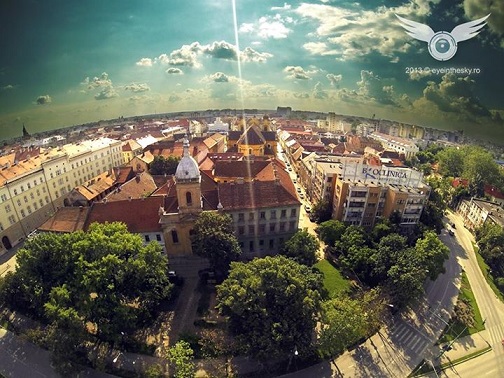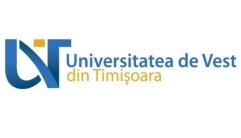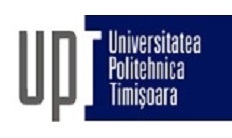Location
Welcome to Timisoara, Romania!
CLICK HERE FOR A CITY TOUR BROCHURE
Timisoara is the county seat of Timis and the most important city in western Romania. It is located in the Banat Plain, on the Bega River. Its territory covers 136 km2 and lies at 45 deg 47 min latitude North and 21deg 15 min longitude East. There are 334,081 inhabitants in Timisoara (over 450,000 with the residents).
The town was first mentioned in a donation act issued by King Andrei II in 1212. It developed during the Dynasty of Anjou, when Carol Robert built a palace that was replaced by the Huniade Castle later.
In July 1552, the Turks conquered Timisoara and made it a Turhish pashalik, The Turkish domination lasted 164 years, until October 18th 1716, when the imperial armies under prince Eugene of Savoy's rule defeated the Turks and entered the town. Consequently, Timisoara went under Viennese administration.
The end of the 19th century and the beginning of the 20th were amrked by the town's strong industrial growth. Timisoara has always been known for its solid educational, scientific and cultural tradition.
Today the town has four state universities (the "Politehnica" University, the University of the West, the University of Medicine and Pharmacy and the University of Agricultural Sciences of Banat) and five private universities.
Timisoara is rich in cultural and artistic traditions, especially in the theatrical and musical fields. The first theatrical performances were staged in the 18th century, only a year after the premiere of the plays in Vienna. Great musicians of the wrols like Franz Liszt, Johannes Brahms, Johann Strauss jr, George Enescu, Bela Barotk, Yehudi Menuhin played for the audience in Timisoara. Starting with the second half of the 19th century, the choral, cretive and performing practices were also strongly encouraged.
There are several institutions that nourish the local effervescent artistic life, among which three national theatres and an opera house in the same building.

In December 1989, after almost 50 years of communist dictatorship, Timisoara became Romania's first free city.
Today, the growing market economy advances on the capitalist path and the industry is centered on six industrial platforms.
the open-mindedness of the people in Timisoara, the peculiar town planning (Romanian tradition combined with Austrian and modern elements), the interesting mixture of cultures (romanian, serbian, hungarian, german), the great material production, the quality of the services and the upstanding cultural life make Timisoara a city worthy of European standards.
The local time in Timisoara is GMT+2.
How to reach Timisoara
There are some
direct flights from European main cities to Timisoara: from Paris (Beauvois), Dortmund, M�nchen (Franz Josef Strauss), Milano-Bergamo (Orio al Serio), Bologna (L. Ridolfi), Rome (Ciampino), Treviso, Verona, London (Luton), Barcelona (El Prat, Madrid (Barajas), Valencia (Manises), Bucharest (H. Coanda)
Also, you can fly to Timisoara via Bucharest, from a lot of international locations
Other close airport (41min of driving on A1 motorway) is Arad. There are direct flights to Arad from Milan (Malpensa) and Bergamo. If you arrive in Bucharest, you can come in Timisoara renting a car (7 h of driving) or by train (8:30 h).
Trains schedule:
http://www.infofer.ro
The official website for travel and tourism:
http://www.romaniatourism.com/
For participants from Hungary, Serbia, Slovenia, and Croatia, we recommend them to come by car, because Timisoara is very close to the Eastern border of Romania with these countries.
Visa information
Please see the
ROMANIA Ministry of Foreign Affairs official website.
West University of Timisoara
Over the last twelve years, the University has responded to changes in national educational policy, to demographic shifts, to a radically different economy and marketplace requirements, to emerging local and regional needs, and to new technologies.
All of these changes have led, in turn, to new expectations on the part of students, staff, and administrators. The University equips individuals with skills needed for effective contribution to society. This work is currently done through eleven faculties that provide a wide range of undergraduate and graduate programs.
The results reached in many programs involving international collaboration - particularly in mobility programs like Socrates, PHARE, Leonardo de Vinci, etc.�are indeed impressive and are among the best achievements of the University.
The overall impression we received of WUT is that of a very creative, energetic, active, and innovative University. All staff members, both teaching and research, are very enthusiastic and determined to experiment with all the new opportunities and modalities offered by I.T. Furthermore good multimedia tools were available in most classrooms in the new buildings, ( e.g. those of Economic Sciences and Law).
Politehnica University of Timisoara
The "Politehnica" University of Timisoara (Romanian: Universitatea �Politehnica� din Timi?oara) is a public university founded on November 11, 1920. Located in Timisoara, Romania, it is one of the largest technical universities in Central and Eastern Europe.
In the recent years, the University through its Regional Centre for Open and Distance Learning has begun to offer open and distance education in different areas and in different languages, supported by new technologies.
The university's research and scientific training is based on the strategy of promoting multidisciplinary research and the priority given to new technology.
The University offers a wide range of facilities (the "Politehnica" University Library, Teleuniversity TV, Politehnica Publishing House, Politehnica Hotel, Hostels, Canteen, sport bases). Each faculty has its own Students' Union that provides support, activities and entertainment (student organizations: LigaAC, LSFEE, LSFETc, LSFMT, LSCT, LSFMPT, OSH, OSTL and the professional student organization BEST - Board of European Students of Technology), which hosts the annual JobShop job fair.
Location of the conference
The conference will be held in A01 amphiteatre from West University of Timisoara, 4 Vasile Parvan Avenue, Timisoara, 300223, Timis, Romania.





 -->
-->